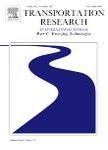版权所有:内蒙古大学图书馆 技术提供:维普资讯• 智图
内蒙古自治区呼和浩特市赛罕区大学西街235号 邮编: 010021

作者机构:Kunming Univ Sci & Technol Fac Transportat Engn Jingming South Rd 727 Kunming 650500 Yunnan Peoples R China Southeast Univ Intelligent Transportat Syst Res Ctr Southeast Univ Rd 2 Nanjing 211189 Jiangsu Peoples R China Univ Maryland Dept Civil & Environm Engn College Pk MD 20742 USA
出 版 物:《TRANSPORTATION RESEARCH PART C-EMERGING TECHNOLOGIES》 (Transp. Res. Part C Emerg. Technol.)
年 卷 期:2025年第171卷
核心收录:
学科分类:08[工学] 0823[工学-交通运输工程]
基 金:National Natural Science Foundation of China open research fund of Intelligent Transportation System Research Cente, Southeast University [2024ITSKF01] Yunnan Xing Dian Talents Plan Young Program [KKRD202202110] Yunnan Fundamental Research Projects [202201BE070001-052, 202201AU070148, 202201AU070109] 52202381
主 题:Metro system Route inference EM algorithm Adaptive mechanism Travel time
摘 要:Due to the dynamic changes in timetables, passenger demand, and passenger composition, the distribution of passengers within a metro system becomes quite complex. Many studies divide a day into intervals to account for the dynamics of travel time. However, the intervals used in these studies are insufficient to capture the gradual and fine-grained changes in passenger travel patterns. This study proposes an adaptive dynamic route inference model (ADRIM) that overcomes these limitations. In the ADRIM, we introduce a constrained Expectation Maximization algorithm (CEM) by confining the parameters of the mixture log-normal distribution model (MLND) within confidence intervals, thereby reducing anomalous estimations. We use the concept of Hidden Markov Models (HMMs) to achieve a parameter-adaptive characterization for the dynamics of route choice and travel time distributions for MLND through an iterative process. For a Nanjing metro case study, the proposed model exhibits superior performance in fitting the actual distribution of travel times and accurately captures the dynamic trends in route travel times. Besides, it is revealed that the maximum difference in expected travel times among multiple valid routes for the same origin-destination (OD) pair primarily falls within the interval [5 min, 15 min], and the distribution range of the maximum ratio is mainly between [1.1, 1.6]. The high consistency in passenger route choice proportions observed for two consecutive weeks, along with an analysis of route choice patterns under dynamic conditions, serves as strong evidence supporting the reliability and practical utility of the dynamic route inference model in understanding and managing metro passenger flows.